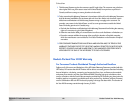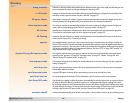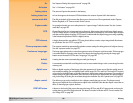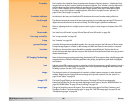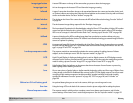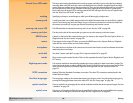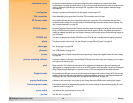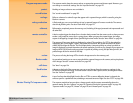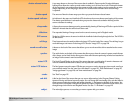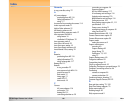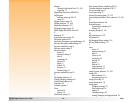
HP 912 Digital Camera User’s Guide 130 Glossary
Manual Focus (MF) mode
The focus mode setting that disables the auto focus system and allows you to select the focus distance
manually. When using MF mode, the camera will display the focus distance, bracketed by left and right
arrows, in the text message area of the top overlay bar. Once you have selected MF mode, you can use the
left and right arrows of the 4-way controller to increase or decrease the focus distance. To change the
focus mode, turn the image LCD on and press the left (AF/MF) soft key in the live view of Capture mode.
See also “Auto Focus (AF) mode” on page 125.
marking
Specifying an image or several images to which you will then apply a single action.
memory card
A small removable, non-volatile storage medium for digital information that acts as the film in a digital
camera. The memory card stores the images so you can process or view them at a later time. Make sure
the camera is powered off any time you remove the memory card from the camera.
memory card access LED
The LED that blinks to indicate the memory card is in use. See also “LED” on page 129.
memory card door
The door on the side of the camera that you open to access the memory card in the camera.
MENU button
A button on the back of the camera that lets you view menus on the image LCD in the Capture, Review, or
Playback mode. See also “modes” on page 130.
menus
These appear on the image LCD when you press the MENU button in the Capture, Review, or Playback
mode and are used to choose and set camera settings.
microphone
The audio device on the front of the camera used to record sound via the sound record button that is then
attached to the current image.
mode dial
See either “camera mode dial” on page 126 or “exposure mode dial” on page 127.
modes
These set the way the camera functions. There are four operational modes: Capture, Review, Playback, and
PC Connect.
Night exposure mode
The exposure mode that automatically optimizes the camera settings for dark scenes taken at night. The
camera opens the shutter to collect ambient light. Then, if the flash is turned on, the camera fires the flash
at the end of the exposure to illuminate objects in the foreground. See also “exposure modes” on
page 127.
NTSC connection
National Television Standards Committee connection. The video (TV) connection standard used in the
United States and Japan.
One Shot image type
The image type setting on the camera that captures one image at a time. You change the image type by
pressing the image type button next to the status LCD. See also “image type” on page 128.
optical resolution
The true resolution of an imaging device, and the resolution at which the device captures images. See also
“resolution” on page 132.
optical zoom
The process of changing the field of view and magnification of the lens by moving different lens groups
within the lens to change its overall focal length. See also “digital zoom” on page 126.



